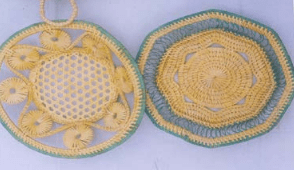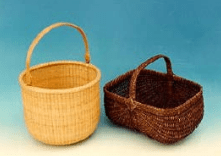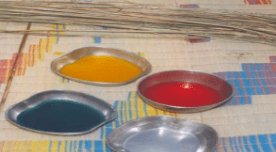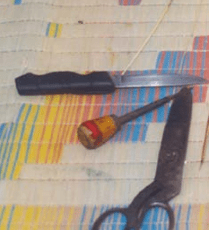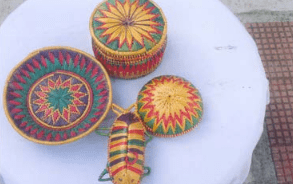Sikki grass weaving
The women of Mithila region of NorthBihar are known for their impressive craft skills. From the early centuries they have been making beautiful Sikki Craft apart from the very famous Mithila Painting, Godna Painting, Papier mache, Sujani Embroidery, Appliqué works etc.
Sikki is a type of grass of golden colour which is grown in the wet and marshy area around rivers and ponds in Mithila region of North Bihar.
History of Sikki grass weaving Craft
Some years ago when there were not so many sources of entertainment in the villages in North Bihar, women used to make different artistic crafts and paintings for their entertainment as well as to make some valuable utility products for their household uses .
In the recent years, with the introduction of the television and other sources of entertainment majority of these girls spend their spare time watching T.V or reading magazines. But in spite of all these changes we can see Sikki work in almost every village in Mithila region of Bihar.
The main areas where the Sikki work is still carried out at a large scale are Madhubani, Darbhanga and Sitamarhi in Bihar. Initially women used to make utilitarian products (different types of baskets) human figures (mainly Gods & Goddesses to worship), and 2D figures of birds and animals.
Sikki is predominantly a women’s craft. Young girls learn to make Sikki craft from their grandmothers or mothers because it is a very old craft of this area and a majority of the old-aged ladies know how to make sikki craft. Girls and bride-to-be take these Sikki products to their husband’s home after marriage as a part of their dowry.
A young bride is judged for her imagination and skill by the various crafted articles she carries. Sikki containers and boxes filled with dry-fruits are also gifted to daughters at the time of marriage.
Similar crafts of Sikki grass weaving
Weaving of baskets in India is an art as old as pottery making. In early times, nomadic food gatherers used to weave reeds together to prepare baskets. Later, different materials and cultures developed a variety of basketry for domestic as well as for ritual purposes.
In India people make baskets out of twigs, bamboo, cane and different types of wild grass.
Punjab is famous for its sturdy spirally built baskets in which sarkanda, a wild grass is used for the basic form which is stitched together with the use of date-palm leaf. The willow baskets of Kashmir are known for its intricate designs.
Uttar Pradesh has tradition of making baskets out of monsoon grass called Moonj. Allahabad and the surrounding villages are famous for this type of baskets.
In the Tarai region of Bihar, the semi – tribal community of Tharus carries on a tradition of basket making which is quite distinct from sikki baskets of Mithila region of North Bihar. Tharus baskets have a bolder form and are decorated with human and animal figures on it. Kulas are the winnowing baskets of Bengal painted with auspicious symbols.
Similarly in south, Mysore is famous for its Cane basketry. Tamil Nadu is famous for the Chettinad baskets. They make intricate patterns with the help of date -palm leaves. These patterns are as fine as embroidery and are the specialty of the Chattiar community of the area.
The North-Eastern region of India has the finest examples of cane and bamboo basketry work. In fact one could say that their lives depend on this material. One can very easily see it everywhere in Assam, Manipur, Meghalaya, Mizoram, Nagaland, Arunachal Pradesh and Tripura. All over the area fine quality bamboo baskets are made and put to various uses.
Raw materials sikki grass weaving
Sikki grass is grown in the wet and marshy area around the rivers and pounds in North Bihar. It is grown in the area of heavy rainfall. This golden grass is usually collected by Harijans in the rainy season. The dry grass is then sold by the mat the Haat or local market by the foot.
The munj (another grass) and khar are other important raw materials for the making of sikki grass products. Munjis much cheaper and more abundant, so it is used to give basic shape and strength in sikki products. At first munj is coiled and then it is covered with sikki grass.
Other raw materials are colours for dyeing of sikki grass. These colours are easily available in the local market. The last and most valuable raw material is water, which is used to soak the sikki grass and make it more pliable as it is coiled around the munj.
Tools of sikki grass weaving
The main tool used by the Maithili women is a 5-6 inches long needle-shaped iron object with a rounded head for grip is called Takua. They also use a very thin knife (choori) for splitting and scissors (kaichi) for cutting the sikki. At times they also use their teeth for splitting sikki grass.
Process of sikki grass weaving
To make the sikki grass usable, it is first cut from its base and then dried for some days. Since the flowering part of the stem of sikki is not used for crafts making, it is discarded and the remaining portion of the sikki is sliced and shaved with the help of a knife or by teeth.
The sikki is characterized by its wonderful beautiful golden colour, so it is also called Golden Grass. It is also colored into different shades of colours e.g. red, yellow, green, deep blue, purple, and pink, etc. with the natural golden colour to make the final product more attractive.
Before use, sikki is soaked in water to make it more pliable as it is coiled around the munj. The colouring is achieved by boiling sikki in different colours. Now the main form is shaped with munj or khar (other type of grass) to provide the basic shape and additional strength to the sikki product. Due to its abundance, generally munj issued for coiling purpose in Maithili region of Bihar.
Then the munj is completely coiled over and covered with sikki so that it is not visible through the encasing. Then the main tool, takua is used carefully because it can also cut sikki if the artisan doesn’t use it carefully. The product being made is held firmly with the left hand while the right hand is completely free to wield the takua.
Maithili women make different designs and patterns in the sikki product by combining dyed sikki with natural golden colour sikki to give it a more artistic and attractive look. It requires not only skill but lots of creativity, concentration and patience.
Utility and range of product
Initially women of Mithila used to make utilitarian products (baskets and containers), 2D-3D figures of Gods, Goddesses (for religious purpose) and animals and birds. But now they are making different variety of utilitarianas well as decorative products according to the demand of the present market.
Utilitarian products
They make different types of traditional containers and boxes for their household purpose e.g.
1. Jhappa-Big containers with caps to store food grains, spices, sweets, etc.
2. Mauni- Trays for fresh fruits, betel leaf and nuts, flowers, etc.
3. Pauti- Beautiful small boxes with caps to keep jewelry, Dry fruits, and other costly items.
4. Gumla- Bowl like containers for various uses.
5. Saji- Flower Baskets.
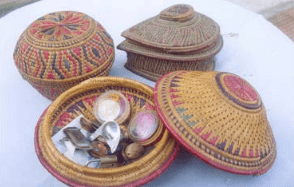
Decorative products of sikki grass weaving
These days artisan of sikki craft artisans are making a variety of decorative products also to get a good place in the national as well as the international market, e.g.
1. Sikki grass coasters
2. Mobile cases
3. Masks
4. Mirror frames
5. Table mats
6. Pencil boxes
7. Hand-held fans
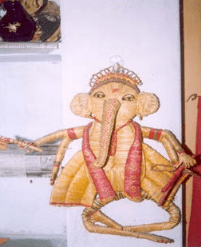
8. Colourful bowls
9. Jewelry Boxes
10. Bangles
11. Toys
12. Pen stands
13. Paper Weights
14. 3-D figures
15. Containers of all types and sizes.
Changes in sikki grass weaving
Design
Although Maithili women have been making beautiful utility products from centuries, now they are aware of the choice of the customers and are trying to make different products according to the demand of the market with respect to the design and shapes.
They make different types of containers with caps to store grains and food, small boxes (Pauti) to keep jewellery and dry fruits and other costly items, trays (Mauni) for fresh fruits and flowers etc.
The variety of product ranges from the traditional masks of Deities to modern mobile cases. Some craftsmen are now experimenting to make sikki products without using munj for coiling purpose.
Market
Sikki craft has a variable price depending on the intricacy and the size of the product. If they participate in any craft fair or exhibition, they get a fair amount of orders for the products they are making.
So, many women in Mithila started sikki craft making it a full-time occupation. This craft is a source of livelihood for them. Majority of them do not get any help from the male member of their family they are willing to participate in craft fairs and exhibitions.
Technological changes
Since the artisan use only 1-2 simple tools for their work, they do not need any change in technology or process.



